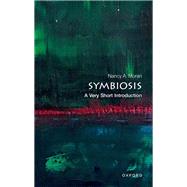
Symbiosis A Very Short Introduction
by Moran, Nancy A.Buy New
Rent Book
Rent Digital
Used Book
We're Sorry
Sold Out
How Marketplace Works:
- This item is offered by an independent seller and not shipped from our warehouse
- Item details like edition and cover design may differ from our description; see seller's comments before ordering.
- Sellers much confirm and ship within two business days; otherwise, the order will be cancelled and refunded.
- Marketplace purchases cannot be returned to eCampus.com. Contact the seller directly for inquiries; if no response within two days, contact customer service.
- Additional shipping costs apply to Marketplace purchases. Review shipping costs at checkout.
Summary
Symbiosis, the sustained and intimate associations between unrelated life forms, is now recognized as a ubiquitous phenomenon, one that has shaped evolution since the origin of life and that continues to affect all species. This overview of symbiosis starts with a quick history of relevant early discoveries and researchers, and considers why symbiosis was so long neglected as a respectable topic of biological research and why it was a controversial topic. Today, symbiosis is widely appreciated as being everywhere in nature and as a pervasive influence on ecological communities. One chapter explores the fundamental drivers that lead to symbiotic associations, using examples ranging from sap-feeding insects to marine flatworms to coniferous forests to illustrate the nature of services exchanged between symbiotic partners. Another considers the evolutionary stability of symbiotic partnerships, which can quickly decay in the face of symbiotic cheating.
Certain symbioses that have had an outsized impact on life on Earth, and on Earth itself, are given particular attention. A full chapter is devoted to the most consequential of all symbioses: the origin of the complex (eukaryotic) cell, and the origin of chloroplasts and green plants. Other triumphs of symbiosis described include the root-fungus associations that enabled plants to colonize land 450 million years ago, gut microbial communities that empower animals to utilize a wide range of foods including plant fiber wood and sap, and coral-algal symbioses that resulted in the rise of coral reefs.
Analyses of genomic DNA have been important in symbiosis research, and this Very Short Introduction describes these molecular approaches, explaining how they sparked discovery of previously unknown symbionts, including those in our own bodies. Molecular data also have enabled us to understand the roles of symbionts within hosts, and the ages of symbiont-host associations, which range from hundreds of millions of years to very recent.
ABOUT THE SERIES: The Very Short Introductions series from Oxford University Press contains hundreds of titles in almost every subject area. These pocket-sized books are the perfect way to get ahead in a new subject quickly. Our expert authors combine facts, analysis, perspective, new ideas, and enthusiasm to make interesting and challenging topics highly readable.
Author Biography
Nancy A. Moran is the Raymer Endowed Chair in Integrative Biology at the University of Texas-Austin. She holds a Ph.D. from the University of Michigan. Her honors include membership in the US National Academy of Sciences and the American Academy of Arts and Sciences, a MacArthur fellowship, the International Prize for Biology, and the Selman Waksman award in microbiology. Moran's research is on symbiosis, especially that between insects and microbes. She explores how symbioses have shaped and continue to shape insect evolution and insect populations.
Table of Contents
An electronic version of this book is available through VitalSource.
This book is viewable on PC, Mac, iPhone, iPad, iPod Touch, and most smartphones.
By purchasing, you will be able to view this book online, as well as download it, for the chosen number of days.
Digital License
You are licensing a digital product for a set duration. Durations are set forth in the product description, with "Lifetime" typically meaning five (5) years of online access and permanent download to a supported device. All licenses are non-transferable.
More details can be found here.
A downloadable version of this book is available through the eCampus Reader or compatible Adobe readers.
Applications are available on iOS, Android, PC, Mac, and Windows Mobile platforms.
Please view the compatibility matrix prior to purchase.
